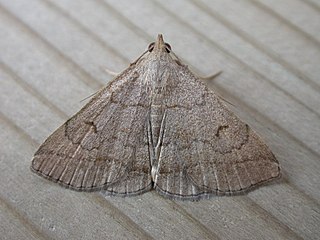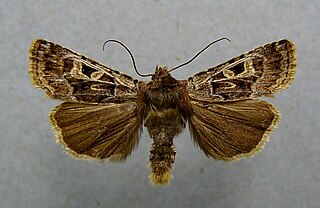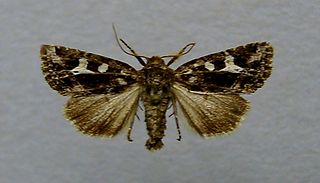
Conistra rubiginosa, the black-spot chestnut, is a moth of the family Noctuidae. The species was first described by Giovanni Antonio Scopoli in his 1763 Entomologia Carniolica. It is found in Europe.

Deltote deceptoria, the pretty marbled, is a moth of the family Noctuidae. The species was first described by Giovanni Antonio Scopoli in his 1763 Entomologia Carniolica. It is found in southern and central Europe.

Panemeria tenebrata, the small yellow underwing, is a moth of the family Noctuidae. The species was first described by Giovanni Antonio Scopoli in his 1763 Entomologia Carniolica. It is found in Europe but is missing in northern Scandinavia, in Portugal, in central and southern Spain, as well as on most Mediterranean islands, except Sicily. In the east, the range extends to the Ural Mountains, but the east distribution limits are still insufficiently known. Occurrence in Asia Minor is uncertain, but it is known from Jordan and Israel.

Caradrina clavipalpis, the pale mottled willow, is a moth of the family Noctuidae. The species was first described by Giovanni Antonio Scopoli in his 1763 Entomologia Carniolica. It is found in the Palearctic realm. It is an introduced species in North America, where it was first reported from Queens in New York City in 1993. In 2009 it was found in Rochester, New York, so it appears to be established and spreading.

Rivula sericealis, the straw dot, is a moth of the family Noctuidae. The species was first described by Giovanni Antonio Scopoli in his 1763 Entomologia Carniolica. It is found in Europe including the Iberian Peninsula and southern Fennoscandia and south to North Africa. In an easterly direction, the species occurs across the Palearctic to the Pacific Ocean and Japan. The species closely resembles Evergestis forficalis.

Zanclognatha lunalis, the jubilee fan-foot, is a moth of the family Noctuidae. The species was first described by Giovanni Antonio Scopoli in his 1763 Entomologia Carniolica. It can be found across the Palearctic realm.

Chersotis cuprea is a moth of the family Noctuidae.

Chersotis ocellina is a moth of the family Noctuidae. It is found in the mountainous areas of Europe, especially in the Alps, the Apennine Mountains, Pyrenees and the Cantabrian mountains.

Cerastis rubricosa, the red chestnut, is a moth of the family Noctuidae. The species was first described by Michael Denis and Ignaz Schiffermüller in 1775. It is found in most of Europe, east through the temperate regions of the Palearctic east to Japan. In the north it is found just north of the Arctic Circle. Southward it is found up to the Mediterranean Basin and Turkey.

Cosmia pyralina, the lunar-spotted pinion, is a moth of the family Noctuidae.

Pyrrhia victorina is a moth of the family Noctuidae. It is found in Bulgaria, Greece, Romania, Slovenia, former Yugoslavia and Daghestan.

The shoulder-striped clover is a species of moth of the family Noctuidae. It is found in most of Europe, Ukraine, southern Russia and southern Siberia, Transbaikalia, Turkey, central Asia, China, Japan, the Korean Peninsula, Mongolia, northern India, Pakistan, the Russian Far East.

Celaena haworthii, or Haworth's minor, is a moth of the family Noctuidae. The species was first described by John Curtis in 1829. It is found from the British Isles and France through northern Europe including Scandinavia, east to the Urals and across the Palearctic to Siberia and up to the Pacific Ocean.

Polia hepatica, the silvery arches, is a moth of the family Noctuidae. The species was first described by Carl Alexander Clerck in 1759. It is found in temperate Europe and east across the Palearctic to Siberia and Korea. It is not present in northernmost Fennoscandia and the southern parts of the Iberian Peninsula, Italy and Greece. It is also absent from Japan.

Shargacucullia prenanthis, the false water betony, is a moth of the family Noctuidae. It is found from south-eastern France, through the Alps and bordering mountains east to Romania and Bulgaria. It is also found in Anatolia and Lebanon.

Chloantha hyperici, the pale-shouldered cloud, is a moth of the family Noctuidae. It is found in southern Central Europe and from southern Europe to the Near East and Anatolia, Israel, Iraq, the Persian Gulf and the Caucasus, as well as northern Denmark, southern Sweden, southern Norway and south-western Finland.

Lithophane furcifera, the conformist, is a moth of the family Noctuidae. The species was first described by Johann Siegfried Hufnagel in 1766. It is found from central Europe, east to the Black Sea region, the Caucasus and western Siberia. In the mountains, it is found up to elevations of 1,800 meters.

The heart moth is a species of moth of the family Noctuidae. It is found locally in Europe. It is also present in Turkey, Transcaucasia, the Caucasus, Israel, Iran and Iraq.

Hoplodrina superstes, also known as the powdered rustic, is a moth of the family Noctuidae, first described by Ferdinand Ochsenheimer in 1816. It is found in Asia and Europe.

Eucarta amethystina is a moth in the family Noctuidae first described by Jacob Hübner in 1803. It is found in central Europe, east to Belarus, through the Ural to the Pacific Ocean.
























